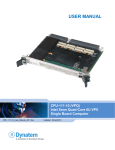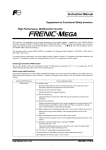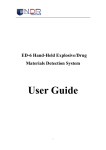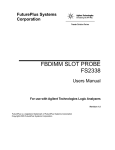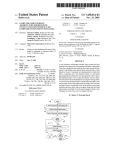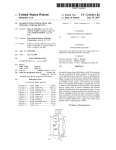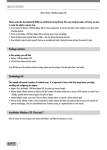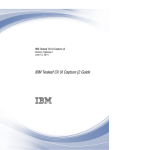Download K-LIMBIC - Med Associates Inc.
Transcript
instrumentation and software for research K-LIMBIC SOF-740 USER’S MANUAL A VERSATILE SYSTEM FOR THE CONTROL OF BEHAVIOURAL EXPERIMENTS DOC-181 Rev. 1.1 Copyright ©2012 All Rights Reserved Med Associates Inc. P.O. Box 319 St. Albans, Vermont 05478 Phone: 802.527.2343 Fax: 802.527.5095 www.med-associates.com Conclusive Marketing Ltd, The Cottage, High Wych Lane, High Wych, Herts, CM21 0JR, United Kingdom. Tel. +44 (0) 1279 724226 Fax. +44 (0) 1279 726177 For product support contact Conclusive Marketing Ltd. Information in this booklet is subject to change without notice. This document is for use by licensed users of K-Limbic, or by persons expressly authorised to use K-Limbic by Conclusive Marketing Ltd. It may be copied and distributed, in whole, to any existing or potential user of the system. Those users shall at their own discretion ignore, disregard, lose or misinterpret this document or the information contained herein. Copyright © 2000 - 2006 Conclusive Marketing Ltd. All rights reserved. Printed in the UK. Document No: Printed: - 2405-01 November 2006 K-Limbic User Manual Contents 1 Introduction 1.1 Supported Hardware 1.2 System Requirements 1.3 Software License Agreement 2 Software Overview 2.1 K-Limbic Terms 2.2 Starting K-Limbic 2.3 The Main Screen 2.4 Resources : Overview 2.5 Protocols : Overview 2.6 Subject Databases : Overview 2.7 Sessions : Overview 2.8 Test Suites : Overview 2.9 K-Limbic Users : Overview 3 Tutorial Guide : Create & Run A K-Limbic Experiment 3.1 Check The User Profile 3.2 Importing Your Protocols 3.3 Create A Development Test Suite 3.4 Build An Installed Test Suite 3.5 Prepare The Test Suite For Use 3.6 How To Load & Run A K-Limbic Session 3.7 What Happens During An Experiment 3.8 Ending A Session Prematurely 3.9 What Happens At The End Of A Session 3.10 Loading The Conflict Session 4 Managing Data 4.1 Data Files Explained 4.2 Automated Analysis Contents i K-Limbic User Manual Introduction 1 Section 1 Introduction 'K-Limbic' is a PC based system for the control of animal behavioural experiments. Designed in collaboration with several international pharmaceutical companies K-Limbic has developed into a versatile, flexible and powerful tool for performing behavioural experiments. The major component in the K-Limbic system is the integrated development environment, (IDE). The IDE provides all the tools required to develop, edit and run your operant experiments. K-Limbic provides a protocol manager to generate, edit and share experimental protocols, a database manager to create databases with subject details and a run manager to run experiments. This document describes the use and control of K-Limbic. Methods of setting up databases, protocols, sessions and test suites are described, allowing the user to configure the system in full. Behavioural experiments use a variety of techniques for selecting experimental parameters such as stimuli, time delays and reinforcement regimes, typical examples of such techniques are fixed ratios, variable intervals and matched, (and non-matched), to position delay values. Historically, the application of these parameters to a specific experimental protocol has required a custom-written program for each particular experiment performed. K-Limbic provides a simple intuitive method of controlling behavioural experiments, thus enabling the user to create individual experiments and please remember all this is done without the requirement for a programmer. The essential themes of the K-Limbic design are ease of use, versatility and reliability, the quality of its development have resulted in the K-Limbic system being in daily use in many of the largest global pharmaceutical companies. The flexible design means that K-Limbic is just as suited to a small independent laboratory or university department as it is to major corporations. The K-Limbic design focuses on the major tasks that are presented to any successful behavioural or cognition laboratory. Experimental task development is made simple by the use of the powerful protocol definition methodology, animal training and maintenance is easy with the use of the subject database, and most importantly K-Limbic is the first, (the only?) operant control system to automatically connect with data analysis macros to archive meaningful datasets on a per-animal or per group basis, (see the later section on automated analyses). K-Limbic User Manual Introduction 2 1.1 Supported Hardware K-Limbic supports the range of interface hardware from Med Associates Inc of Georgia, Vermont, USA. The Med Associates hardware is a combination of components :• • • • A special purpose PCI timer/digital I/O card, (DG704) Any of the SG range of interface chassis 1 or more digital interface cards from the Med Associates range Additional purpose specific hardware, (experiment specific). The Med Associates range of interface hardware is capable of controlling a wide variety of operant equipment; typical examples would be low-voltage lights, retractable levers, pellet dispensers, solenoid valves and switch inputs. However, interfaces can be provided to control a limitless range of customer specific items, please contact Conclusive if you have a requirement for an unusual piece of equipment. For a full description of the Med Associates interface hardware, please refer to Med Associates Inc. K-Limbic User Manual Introduction 3 1.2 System Requirements To use K-Limbic you will need :• An industry standard PC, e.g. Intel Pentium IV based computer, OS - Microsoft Windows XP. • The K-Limbic Installation CD. • A K-Limbic USB security key • Suitable interface hardware The power and capabilities of computing devices increase with great speed and regularity. Additionally the demands of software and computing environments continuously require computers of greater speed and capacity. The following specifications should be considered a minimum for running K-Limbic: • • • • • Intel Pentium processor or similar Windows XP/2000 128MB RAM or more, (512MB recommended) 20MB HDD space PCI bus card slot available It is probable that the computing environment, (e.g. the network), will determine the minimum requirements for the PC, please ensure that the computer used for running K-Limbic is suitable for the environment in which it is to be used. If in any doubt contact your supplier or IT department who will advise on a suitable machine for your purposes. K-Limbic is not a demanding software application, however as is the case with any system used for the performance of real-time experiments, the use of the computer whilst it is running an experiment should be limited to essential functions only. I’m not saying that using your PC to rip your favourite tunes onto your MP3 player will cause K-Limbic to crash, but then I’m not saying it will help either! K-Limbic User Manual Introduction 4 1.3 Software License Agreement 1. Conclusive Marketing Limited hereinafter referred to as CML agree to grant, and the user agrees to accept on the following terms and conditions, a non-transferable and non-exclusive Licence to use K-Limbic. 2. Terms of Licence The agreement is effective from the date of receipt by the User of the above referenced Software and the User's acceptance of the terms and conditions by loading the Software into any Computer. 3. Licence Each Software Licence granted under this Agreement authorises the User to use the Licensed Software in any machine-readable form on any single computer system. This agreement and any of the Licenses, programs or materials to which it applies may not be assigned, sub-Licensed or otherwise transferred by the User without prior written consent from CML. No right to print or copy in whole or in part, the Licensed Software is granted except as expressly provided under this Agreement or given by law. 4. Permission to copy Licensed Programs (I) The User shall NOT copy, in whole or in part, any licensed documentation, which is provided by CML in, printed form under this Agreement. (ii) Any Licensed Software which is provided by CML in machine readable form may be copied in whole or in part in sufficient number for use by the User to understand the contents of such machine readable material and for back-up purposes, provided however, that no more than five copies may be in existence under any Licence at any one time without prior written consent from CML. (iii) The User shall NOT modify, adapt, merge, translate, reverse engineer, decompile, disassemble or create derivative works based on whole or any part of the Software or it's associated documentation. 5. Protection and Security The User agrees not to provide or otherwise make available any Licensed Software to any person other than his employees and/or agents without prior written consent from CML. 6. Termination Within one month of the termination of the Licence under this Agreement, the User will furnish CML a letter verifying that through his best efforts, and to the best of his knowledge, the original and copies in whole or part, in any form, including partial copies of the Licensed Software received or made in connection with such Licence have been destroyed. 7. Disclaimer of Warranty CML makes no warranties with respect to the Licensed Software other than to guarantee the original distribution disk against faulty materials or workmanship for 90 days from the date the Licence was accepted, providing the installation instructions contained in the manual have been followed correctly. 8. Limitation of Liability THE ABOVE MENTIONED WARRANTY IS IN LIEU OF ALL OTHER WARRANTIES, EXPRESS OR IMPLIED. IN NO EVENT WILL CML BE LIABLE FOR CONSEQUENTIAL LOSS OR DAMAGE HOWSOEVER CAUSED (EVEN IF CML HAS BEEN ADVISED OF THE POSSIBILITY OF SUCH DAMAGE). 9. General If any of the above provisions or portions thereof are deemed invalid under any applicable Law or Act of Parliament, they are to that extent only deemed to be omitted. 10. The Governing Law The Governing Law of the Agreement shall be that of England. 11. Acknowledgement YOU ACKNOWLEDGE THAT YOU HAVE READ THIS AGREEMENT, UNDERSTAND IT, AND AGREE TO BE BOUND BY ITS TERMS AND CONDITIONS. K-Limbic User manual Software Overview 5 Section 2 Software Overview 2.1 K-Limbic Terms Resources, Protocols, Subject Databases, Sessions & Test Suites As with all software applications, K-Limbic has its own vocabulary, (that is a collection of terms that are used in a specific manner). This section provides a definition of the commonly used terms where their meaning is specific within K-Limbic. Resources A resource is any item of stimulus or response equipment placed within the animal chamber and connected to K-Limbic. Typical examples are lights, levers, position sensors etc. Experimental environments, (e.g. animal chambers, mazes etc), are defined within K-Limbic as a list of resources. Protocols An individual experiment is described in K-Limbic as a Protocol. The protocol contains the information necessary to define an experiment from start to finish. Subject Databases Subject databases are lists of subjects, (animals). The operator assigns a subject to a box during the process of starting an experiment. Each subject contains a unique set of parameters that have been predefined by the operator, the values of the various parameters are used by K-Limbic to customise a protocol for an individual animal. For example during training for any complex task novice animals will commence a task using a set of parameters suitable for a novice, as animals progress the task parameters increase in difficulty, using a subject database provides a simple method of customising any task to the current training level of a subject. Sessions A K-Limbic experiment is run as a session. The session file defines how many boxes will run, which subject database will be used, where the data is stored and how the data is analysed. Test Suites A test suite is a wrapper for sessions and databases. An individual test suite can contain up to 20 different session definitions and 20 different databases. Therefore a single test suite file can contain everything you will need to define a complete study, including training sessions, test sessions and maintenance sessions. K-Limbic defines two forms of test suite, “Development Test Suites” and “Installed Test Suites”; these are discussed in more detail later. K-Limbic User manual Software Overview 2.2 Starting K-Limbic The K-Limbic installation program creates a K-Limbic item on the Start menu… All Programs >> K-Limbic >> K-Limbic System Select this item to start the K-Limbic application. K-Limbic will present the log in window, select the appropriate user name from the list and enter the appropriate password. 6 K-Limbic User manual Software Overview 7 2.3 The Main Screen Enter K-Limbic by selecting the K-Limbic item from the Windows Start Menu and log in. The software is loaded and presents the main screen to the user. The main screen components are listed below: 1. 2. 3. 4. 5. The main menu The main menu appears below the title bar, the main menu gives the user access to the various functions of K-Limbic. The toolbar The toolbar gives shortcut access to the main management windows of K-Limbic The user details section The user details section gives an outline of the protocols and test suites that the current user has defined. The Test Suite section The Test Suite section lists the primary database for the current test suite, (if one is loaded); this area also lists the recent activities performed with the test suite. The System Log The system log is a list of recent activity that has occurred using K-Limbic. The system log holds data for up to ten days. K-Limbic User manual Software Overview 8 2.4 Resources : Overview A 'Resource' is a single item of operant equipment; a list of the resources which are currently supported by K-Limbic is given in table 2.1. K-Limbic defines an operant enclosure as of a collection of 'resources', i.e. a group of associated levers, lights, doors etc. K-Limbic controls the state of an operant enclosure by controlling the state of each resource in the resources list of the protocol. Table 2.1 Available K-Limbic Resources Retractable Levers Cue Lights Lights Door Control Tone Generator Pellet Dispenser Fluid Dispenser Auxiliary Dispenser Shock Trigger Lever Press Sensor Sensor Nose Poke Sensor Position Sensor The resources present in any one operant enclosure will vary depending on the nature of the experiment it is used for. A K-Limbic developer configures a collection of resources as a part of the protocol description. The state of each configured resource is controlled at every stage of the protocol thus controlling the state of the operant enclosure. Refer to the Guide to Protocols manual for precise details of each of the resource types. K-Limbic requires a reference file to inform it of the corresponding interface channel for each resource. This file is maintained by the user, refer to the 'K-Limbic Installation & Configuration Manual' for details on editing the resource configuration file. Using this technique a protocol becomes “system independent”, i.e. the same protocol can be used on different systems even if the hardware is connected in a different manner. K-Limbic User manual Software Overview 9 2.5 Protocols : Overview K-Limbic is a tool for performing user-defined experiments. The method provided for the user to define the actions of an experiment is the protocol. A K-Limbic protocol is a series of stages, at each stage the current state of an operant enclosure is fully defined, i.e. the state of any resources present in the enclosure is specified. The required experiment must be split into distinct stages, (this is most easily represented as a graphical flowchart). Movement between stages is triggered by a trigger event, examples of trigger events are timeouts, lever presses and nose pokes. The protocol description is defined using a number of “components”. These are as follows: • • • • • The Resources component, (the items required in the operant chamber) The Stages component, (a list of stages for the experiment) The Endpoints component, (a list of endpoint conditions) The Process component, (the flow between stages) The Auto Parameters component, (how to customise the protocol for individual subjects) K-Limbic stages encapsulate much of the “expertise” required to define an experiment. This makes defining protocols far easier. The different stage types can extract information from the subject database so that details such as fixed ratios, variable intervals, delays or target lever assignments become automatic. A range of stage types is available to cater for various experimental situations; the range of stage types is listed in table 2.2. The majority of stage types are used for defining the state of the operant enclosure, however additional stages are available for sending messages to the screen display, updating the output file and controlling the flow of the protocol. Table 2.2 : Predefined K-Limbic Stage Types Stage Type Initial Stage Exit Stage Action Reward Trial Mark Trial/Set Outcome Fixed Ratio Variable Interval Shadow Stage Timer Stage Serial Choice - Inter-Trial Interval Serial Choice - Present Stimulus Serial Choice – Collection Serial Choice – Timeout Serial Choice – Training Interval Stage Delay Stage Progressive Ratio Stage Cued Choice Stage Sequential Choice Stage Cued Lever Stage Epoch Control Stage Outcome Stage DRL Stage Timeout Stage Location Stage Function Sets the initial state of the operant box, (state prior to starting the protocol). Sets the exit state of the protocol, (state following completion of protocol). Waits for a trigger to occur Dispenses a reward, (reinforcement). Increments the trial number & defines the outcome of a trial, (e.g. correct/incorrect etc). Runs a fixed ratio. Runs a variable interval. Responds to the activation of a shadow trigger. Used To Time the period of activation of a sensor. The ITI stage of the 5CSRTT. The stimulus & limited hold of the 5CSRTT. The “Wait for collection” stage of the 5CSRTT. The “Timeout” stage of the 5CSRTT. A training stage for the %CSRTT. A fixed or variable interval stage Waits for a specified delay to occur. Implements a progressive ratio schedule Used in DNMTP protocols Defines a series of responses Defines a cued lever stage Controls the epoch manager Set the outcome of a trial Used in DRL tests A general timeout stage Defines the location of a subject. K-Limbic User manual Software Overview 10 To operate a K-Limbic system it is not necessary to understand the details of how to define a protocol, so full details will not be discussed here. Protocol definitions are discussed in more detail in the KLimbic Developers Guide document. Many users never generate their own protocols, they simply ++ contact Conclusive and we generate them for you, (free of charge ). All you will need to know is how to import the protocol file onto your system and how to incorporate the file into your test suites, (see the Tutorial guide section). ++ Yes, that’s FREE OF CHARGE!!! The important thing to note is that protocol definitions are generic, the protocol manager interacts with the details held in the database parameters of an individual subject to customise the protocol to a given subject. For example, in the well-known “delayed match to position” task the database parameters determine the number of trials to be performed, the delay values to be used, the maximum time allowed for the experiment, whether or not the task is “matched to position” or “non-matched to position”, whether or not incorrect trials are repeated and whether or not trials are organised in “banks”. As the details are subject specific you can run a session in which the details of the protocol run in box1 are completely different from the protocol run in box 2 etc. This is achieved simply by assigning a subject to a chamber! The list in table 2.2 details the various stages available to build a protocol. If you have a protocol that is not catered for by the current stages Conclusive want to hear from you, (we like nothing more than adding new stuff into K-Limbic). Contact us with your requirements and we will add in the necessary controls to create your protocol, we can do this quickly and efficiently, (normally the longest process is communicating the details of the task), once your new facilities are added you will be able to adapt and run new protocols. Please remember Conclusive guarantee that we will not charge for making additions to K-Limbic for any currently supported K-Limbic system. K-Limbic User manual Software Overview 11 2.6 Subject Databases : Overview K-Limbic provides a database utility for the storage of experiment details unique to individual subjects. Database parameters are central to the use of K-Limbic. Database parameters interact with the protocol definition to create an experiment customised to the individual subject. A subject database may store information on a very large number of subjects, (i.e. in excess of 1000), however it is recommended that databases are organised on a study basis, i.e. if a particular study consists of 64 subjects, then create a separate database for these subjects. K-Limbic can support any number of databases. Databases are stored within installed test suite files. It is possible to maintain an arbitrary number of test suites on a K-Limbic system, the number and size being restricted by the available storage space, however on most modern computers the space available is so large that it can be considered that an unlimited number of test suites can be supported. K-Limbic provides utilities for creating and maintaining databases; these are described later. It is advisable to become familiar with the operation and maintenance of databases before using the system in a "live" study. All subjects in a database contain the following items: • A Rewards Table • A Dosing List • A Parameters List The Rewards Table stores a list of entries appropriate for delivering rewards and (ironically), shocks. The table entries define a series of “pulses” or “triggers”. In the case of a protocol that only uses a pellet dispenser this table only requires a single entry defining a pulse long enough to trigger the pellet dispenser, the duration of the pulse required varies depending on the manufacturer of the pellet dispenser but 100mS is a typical pulse duration. Protocols that deliver foot shocks as well as pellets will need two entries in the rewards table, one to define the pellet delivery pulse and one to specify the duration of the foot shock. If alternative methods of reward delivery are used, such as syringe pumps or pellet dippers, the pulse duration will need to be determined by experimentation. The Dosing List defines a list of doses that will be given to the subject during any given study. The appropriate dose is selected from the dosing list during the process of loading a session prior to running an experiment. The dose details appear in the output data file and can be included in the data analysis worksheets, (see later discussion on managing data). Using suitable dosing lists is not essential to running K-Limbic but they can be used to save a lot of time when it comes to analysing data. The Parameters List stores a collection of protocol specific parameters. The parameter values are used to customise a given protocol for a specific subject. Refer to the documentation on your protocol to determine which database parameters are required for your protocol. K-Limbic User manual Software Overview 12 2.7 Sessions : Overview K-Limbic runs experiments in sessions, a session may run individual experiments in any or all the boxes attached to the system. The configuration of a session consists of setting the following details: 1. 2. 3. 4. 5. 6. 7. 8. 9. Arbitrary text fields for the session 'reference’. The “Run List”, (the number of boxes used in the session, 1 - 16). Assignment of protocols to boxes, (one protocol per box). The database from which subjects will be selected. The destination folder for the data files output from the session. The connection details for the automated data analysis. The display type used for the session. The Auto Control mode. Enable controls for session specific items. Sessions are defined and stored within test suites. A single test suite can contain up to 20 session definitions. A session definition includes the destination folder for the data files created by running the session. Using different sessions allows the operator to keep the data files for different experiments or groups of animals separate. Sessions can be kept separate either by using multiple sessions in the same test suite file, or using single sessions in multiple test suite files, the preferred organisation is left up to the individual operator. Items 7, 8 & 9 in the list above are collectively referred to as the “auxiliary controls” of the session. Full details of how to configure, load and run sessions is described in the tutorial guide “Create & Run A K-Limbic Experiment”. K-Limbic User manual Software Overview 13 2.8 Test Suites : Overview A test suite is a wrapper for sessions and databases. An individual test suite can contain up to 20 different session definitions and 20 different databases. Therefore a single test suite file can contain everything you will need to define a complete study, including training sessions, test sessions and maintenance sessions. K-Limbic defines two forms of test suite, “Development Test Suites” and “Installed Test Suites”. Development Test Suites A K-Limbic developer creates and maintains Development Test Suites. Development Test Suites are a “Template” from which “Installed Test Suites” are built. A K-Limbic developer must create, (or import), the required protocols before creating a development test suite. A development test suite contains the basic information required to build an installed test suite. Development Test Suites contain the following information: 1. 2. 3. 4. User defined title User defined description A Database Template One or more Session definitions The database template contains a template version of the database parameters required to run the protocols contained in the sessions list. Using the database template significantly reduces the effort required to create and maintain fully populated databases. Each session in the sessions list contains a collection of references to protocols, (as opposed to the protocols themselves). Development test suites cannot run experiments; development test suites are templates from which “Installed Test Suites” are built. K-Limbic User manual Software Overview 14 Installed Test Suites Installed test suites are built from development test suites. Installed test suites contain all the information and settings required to run a K-Limbic experiment. When a development test suite is “built” into an installed test suite the protocol references are resolved and a copy of the appropriate protocol is stored in the installed test suite. If the current operator, (or any other operator), changes the original protocol details, the details stored in the installed test suites WILL NOT change. Of course it is possible to update an installed test suite should you wish to do so, but this does not happen automatically. Once an installed test suite is built, changes to the original protocol are not reflected in the installed test suite. A newly built “installed test suite” requires further information before it’s sessions can be run: The database(s) must be populated with a suitable number of subjects, (probably built from the database template). The data output details of any session that creates data need to be set up. The auxiliary details of the sessions may be altered. An installed test suite is located in a separate data file. It is the basic unit from which experiments are run. It is possible to import and export installed test suites between systems, it is even possible to disassemble an installed test suite into its constituent development test suite and protocols. Therefore the installed test suite is a very convenient method through which experiments can be transferred between experimenters. The protocol definitions for each session are stored within the installed test suite. The implication of this is that any changes made to the protocol using the protocol manager will not change the protocol definitions in the installed test suite. This is a security measure added to prevent inadvertent modifications to the protocols running in existing installed test suites. It is of course possible to update the protocols in existing installed test suites should changes be required. K-Limbic User manual Software Overview 15 2.9 K-Limbic Users : Overview It is envisaged that a single experimental system will be used for a variety of experiments by a number of users. K-Limbic is designed to cater for a multi-user environment by incorporating the concept of password protected 'Users'. Assigning a User account to an individual results in improved security of the system, as separate users can keep their own configuration files separate. It is up to the individual laboratory to determine whether or not to they wish to utilise the concept of “users”, it is not essential to do so. Many laboratories use K-Limbic systems that have just one “User” defined. When a single K-Limbic “User” is defined everybody who uses that K-Limbic system accesses it through the one user account. When the K-Limbic application starts the user is prompted to log-on. Each user account has an associated password; the person logging on should select the appropriate user from the list of users and enter the corresponding password. Once the user has logged on they have access to all of that users details, plus the details from the currently active group. Profiles Profiles are a way for a user to separate different type of experiments, for instance if a user has protocols for use in a five choice type chamber and protocols for use in a standard “Skinner” box, then it is possible to keep these differing forms of experiment in separate user profiles, say a “Five Choice” profile and an “Operant” profile. A single profile is active at any time so if the currently active profile is the Five Choice profile then only the five choice protocols and development test suites will be visible, changing the active profile to the Operant profile will hide the five choice protocols and test suites and display the Operant protocols and test suites. Each profile has an associated resource list. The purpose of the “Profile” resource list is discussed in the “K-Limbic Developers Guide” document. Groups Each K-Limbic user must be a member of at least one user group, (the minimum configuration of KLimbic contains one user and one user group). Any member of a user group has access to all installed test suites created by members of the group, this way experiments can be performed by any user who is a member of the same user group. User Privileges Each user is granted a number of privileges, the privileges determine what each user to allowed to do with K-Limbic. The user privileges are: • Operator • Developer • Administrator A user who is granted operator privileges is allowed to load and run K-Limbic experiments from Installed test suites. A user who is granted developer privileges is allowed to create, edit and maintain protocol files, and development test suites and to build installed test suites from development test suites. A user who is granted Administrator privileges is permitted access to the system configuration tools. K-Limbic User manual Tutorial Guide 16 Section 3 Tutorial Guide Create & Run A K-Limbic Experiment The following sections give a step-by-step guide on how to perform a number of common functions using K-Limbic. If K-Limbic has not been installed on the machine you are using refer to the installation and configuration instructions in the “K-Limbic Installation & Configuration Manual”, (separate document). This guide assumes that you have followed the instructions detailed in the “K-Limbic Installation & Configuration Manual”. The instructions here detail the actions required to perform “Option 2” in the “What To Do Next” section of that manual. This tutorial guide explains the process required to develop, install and run a “Conflict” style experiment, (also known as the Geller-Seifter task). Similar tutorial guides are available for other common tasks, such as 5CSRTT, DNMTP, CER etc. These instructions will detail how to… 1. Check that the user profile is correctly assigned. 2. Import a protocol, (as an example we will import a “Conflict” type protocol and an FR type training protocol). 3. Create a Development Test Suite, define sessions and a database template 4. Build an Installed Test Suite from our Development Test Suite. 5. Prepare the Installed Test Suite for use 6. Load and run the sessions within the Test Suite. For tutorial guides on alternative common behavioural tasks refer to the “Repository” folder on the installation CD. 3.1 Check The User Profile The default user contains an operant profile and a five choice profile, each profile has it’s own resource list, (this is different from the resource list that was configured during the installation). The resources in the user profile are used at certain points in the process of developing protocols and editing databases. The use of a separate resource list allows a user to develop a protocol, or test suite, on a K-Limbic system even if the system is not configured to run that protocol. K-Limbic displays the current user name, group name and profile in the status bar at the bottom of the main screen. It is useful to check that the settings are correct before commencing the development of a new test suite. From the K-Limbic main menu select… File / User / Configure User… This will present the “Configure User Details” window. The “Current Groups” list will contain a single entry, “Operant Group”, if this entry does not have an arrow next to it with “Current” written on the right, then select the “Operant Group” entry in the list and click on the “Assign As Current” button, this will connect the current user to all the files available to the “Operant” group. If the “Current Groups” list contains more than one group, then your system has been configured to use a number of user groups, contact your K-Limbic system administrator for advice on how they have assigned the groups, to determine which group is appropriate. It is also possible to modify the password for the current subject using the “Modify Password” button. K-Limbic User manual Tutorial Guide Click on “OK” to close the “Configure User Details” window. From the K-Limbic main menu select… File / User / Profile Manager… This will present the “Profile Manager” window. The default user contains two profiles, “Operant” and “Five Choice”, the appropriate profile for the Conflict task is the “Operant” profile, select the “Operant” entry in the “Profiles” list and click on the “Assign As Current” button, the “Operant” profile will be marked as “Current”. Click on the “Quit” button to close the “Profile Manager” window. This completes the check of the user profile. Figure 3.1 Profile Manager Window 17 K-Limbic User manual Tutorial Guide 3.2 Import Your Protocols Protocols are created, edited and managed using the “Protocol Manager”. From the K-Limbic main menu select… Protocols / Protocol Manager… (or press function key F3) This will present the “Protocol Manager” window. Figure 3.2 Protocol Manager Window The window contains a list of the protocols installed for the current user, (unlike the diagram above, initially this list will be empty). Below the list of protocols are a number of buttons used to perform a variety of actions. 18 K-Limbic User manual Tutorial Guide 19 Import The Protocol Click on the “Import…” button, this will present the “Import Protocol” window. Leave the top option set on “Import From File” and click on the “Select Source…” button; this will present an open file dialog titled “Select Protocol File”, which is asking you to locate the required file. The default location presented by the “Select Protocol File” dialog is the “Import” folder of K-Limbic, however we have not put any protocol files at this location, (although you could use Windows Explorer to do so), so we will need to navigate to a suitable location. The K-Limbic installation CD contains a collection of predefined protocols that are available for use, alternatively contact Conclusive we will be happy to send you a protocol file suitable to your requirements. We will use a protocol from the CD. Browse to the location… Q:\K-Limbic Repository\240400 Where you will find the protocol… 240400-Conflict.prc (“Q” represents your computers CD drive) This is a Conflict style procedure using a combination of unpunished and punished phases. Select the above file and click on the “Open” button. This opens the protocol file, but has not yet imported it. Click on the “Import” button and then click on “OK” and the protocol will be imported. Click on “OK” twice to close the “Import Protocol” window. The list of protocols will update and show the file that has just been imported. Figure 3.3 Import Protocol Window K-Limbic User manual Tutorial Guide 20 Now repeat the import process and browse to the location Q:\Klimbic-Repository\240400 (“Q” represents your computers CD drive) Where you will find the protocol… 240401-FR.prc This is a simple protocol implementing a basic FR schedule and is intended for novice animal training. Import the protocol and return to the protocol manager as before. This completes the actions required in the protocol manager, The protocols list will now have two protocols listed, if desired you can use the “Edit Protocol…” button to view the details required for the protocol definition, (although this is not a requirement), take care not to change any of the settings however or you may change the actions of the protocol. Click on the “Exit” button to close the protocol manager. K-Limbic User manual Tutorial Guide 21 3.3 Create A Development Test Suite Test Suites are created, edited and managed using the “Test Suite Manager”. From the K-Limbic main menu select… Test Suites / Test Suite Manager… (or press function key F4) This will present the “Test Suite Manager” window. Figure 3.4 Test Suite Manager Window The window contains two tabbed pages, one page for “Development Test Suites” the other for “Installed Test Suites”, select the “Development Test Suite” page. The “Development Test Suite” page contains a list of the Development Test Suites installed for the current user, (initially this list will be empty). Below the list of Test Suites are a number of buttons used to perform a variety of actions. Click on the “New Test Suite…” button, this presents a window asking you enter the Reference, Title and Description for the new test suite. Each of these entries are user defined, so you can enter whatever you like for these entries, although the Reference entry must be unique. For Development test suites I tend to use a descriptive value, so suggested entries are as follows: K-Limbic User manual Figure 3.5 Test Suite Header Details Click on the “OK” button and the list updates to display the new Test Suite. Tutorial Guide 22 K-Limbic User manual Tutorial Guide 23 Launch The “Configure Test Suite” Window Select the new “Conflict 101” test suite and click on the “Edit Test Suite…” button, this presents the “Configure Test Suite” window with the “Conflict 101” Test Suite loaded. Figure 3.6 Configure Test Suite Header Window (Figure 3.6 illustrates the state of the test suite after the sessions have been configured) The items we need to configure are: • The Database Template • The Sessions The Database Template Explained The Database Template will assist us when we need to populate the subject database, (the list of animals we will use for the experiments). The Database Template should contain all the database parameters necessary to run the protocols in the Test Suite. Pre-defining the Database Template is not essential, but it is recommended. The more we pre-define at this point the easier it becomes to maintain the database later on, especially for experiments where there is a requirement to train animals to perform the task. In many cases it is possible to pre-define all the steps required to train animals from novice level right through to fully trained. For new users of K-Limbic this sometimes sounds a little daunting, we haven’t even started training animals yet and we should pre-define what is going to happen in several weeks time? Well, (a) remember what has happened in the past, training regimes you, (or someone else), have followed before you will probably use again, pre-defining things here simply helps this process and (b) if your pre-defined values are inappropriate it is very easy to change them. K-Limbic User manual Tutorial Guide 24 Required Database Parameters So what database parameters do we need to run the Conflict protocols? In general it is necessary to examine the documentation for a protocol to determine this, the Protocol Guides produced by Conclusive always contain a section on the required database parameters, however for brevity the required parameters are detailed here: Protocol 240400 - Conflict VI/FR Parameters VI/FR parameters are a combined set of database parameters, they pair a VI, (variable interval), parameter with an FR, (fixed ratio), parameter. VI/FR parameters may be present in the database as either a single VI/FR entry or as a table of VI/FR entries. Using a table of entries is the preferred method. The VI stage of the protocol uses the VI settings and the FR stage of the protocol uses the FR settings. Selected Lever Parameters Using “Selected Lever” parameters provides a simple method of assigning a “Target” lever to a subject, in the Conflict protocol a single lever is presented to the animal. The “Selected Lever” parameters determine whether this is the left or right lever. It is recommended that the database be arranged so that in any given chamber the left lever is used half the time and the right lever used for the other half, this is easy to organise by suitable manipulation of the Selected Lever settings. Protocol 240401 - FR The FR protocol whilst being very simple actually requires more database parameters, this is because the protocol is kept as generic as possible to cater for a wide range of preferences. The FR protocol will use the same “Target” lever for each subject as the Conflict protocol. The FR protocol is defined to end after a given number of pellets have been delivered or after a given amount of time has elapsed. VI/FR Parameters See above Selected Lever Parameters See above Endpoints – Timeout Table Define an Endpoint – Timeout Table with a single entry, the time set in this entry will be the maximum duration of the FR protocol, (15 minutes). Endpoints – Counts Table Define an Endpoint – Counts Table with a single entry, set the “Trials All” value in this entry, this will be the maximum number of trials in the FR protocol, since one pellet is delivered per trial this also controls the number of pellets delivered, (100). Rewards Table The rewards table for the Conflict protocols requires two entries; the first entry specifies the pulse duration for the pellet dispenser, set this value to 100mS. The second entry in the rewards table specifies the pulse duration for the foot shock, set this value to the appropriate time for your experiment, (typical value 500mS). Dosing List Set the dosing list to be appropriate for training the animals, i.e. a single “No Dose” entry, it is possible to pre-define the dosing list, but probably not worth doing so here. If the Dosing List contains a single entry, then that entry automatically becomes the value that will appear in the output data file, (default entry). If the Dosing List contains a default entry K-Limbic will not present the Dosing List to the operator during the session load process. Configure The Database Template The good news is that you do not have to configure the Database Template yourself, simply import the pre-defined Template from the installation disk. In the “Configure Test Suite” window, click on the “Configure Database Template” button, this presents the “Edit Database Template” window. Click on the “Import…” button, this presents the “Import Database” window. Click on the “Browse” button, this presents the “Open Database” window, navigate to the location Q:\K-Limbic Repository\240400 (‘Q” represents the Installation CD). Where you will find the database file… 240400.dbk K-Limbic User manual Tutorial Guide 25 Click on the “Open” button, this opens the database but it is not yet imported. Click on the “Import Database” button and the database is imported. Click on the “OK” button and the new Database Template is copied into the Test Suite, (deleting any values already present in the existing Template). Click on “OK” to close the “Edit Database Template” window and return to the “Configure test Suite” window. The predefined template contains all the values identified above, the Selected Lever is assigned to Lever <1>, (the left lever in most cases), the VI/FR Table contains an example list of training levels from novice, (training level 1), to ready for testing, (training level 8). It is left as an exercise for the user to examine the contents of the Template and make changes as and where necessary. Configure The Sessions The Conflict Test Suite requires two sessions, one for the FR training protocol and one for the Conflict protocol. In the “Sessions” section of the “Configure Test Suite” window, click on the “Add” button twice, this will add two empty sessions to the Test Suite, the Sessions are titled “Session 1” and “Session 2”. Conflict Session We will set up all boxes in the Conflict Session to run the Conflict task protocol… Select “Session 1” in the Sessions list and click on the “Edit…” button, this presents the “Configure Session” window. We will configure this Session as the Conflict task session. Figure 3.7 Configure Session Window Modify the “Reference” entry to a meaningful value, e.g. “Conflict Session” K-Limbic User manual Tutorial Guide 26 Click on the “Configure Run List” button to present the “Configure Run List” window, (this is where we tell K-Limbic how many boxes to run and which protocol to run in which box). Click the “Add Box” button once: this adds an empty box to the run list. Select the Conflict Task protocol, reference 240400, in the “Protocols” list and click on the “Assign Protocol To Box” button: this configures Box 1 to run the Conflict Task protocol. Click on the “Add Box” button again, this will add another box to the Run List, by default this box will run the same protocol as Box 1, which is what we want. Click again on “Add Box” until the Run List contains the correct number of boxes, all running the Conflict Task protocol, you need one entry in the Run List for each box in your system. Figure 3.8 Configure Run List Window When the Run List is complete, click on the “OK” button to return to the “Configure Session” window. Back in the Configure Session window… Set the “Display Type” to a suitable value, there is no specific display for the Conflict Task, (one can be added if required); a suitable Display would be “Response Counts (Levers, Magazine Sensor, Rewards)”. “Auto Control Mode” should remain as “Use Subject Parameters”. “Enable Dose List” should be checked. “Enable Event Log” should be unchecked. “Enable Shocks” should be checked if you wish shocks to be delivered during the session. “Enable Shocks” should be unchecked if you wish shocks to be disabled during the session. This completes the configuration of the Conflict Session, click on the “OK” button to return to the “Configure Test Suite” window. Training Session We will set up all boxes in the Training Session to run the FR Training protocol… Select “Session 2” in the Sessions list and click on the “Edit…” button, this presents the “Configure Session” window. We will configure this Session as the Training session. Modify the “Reference” entry to a meaningful value, e.g. “Training Session” Click on the “Configure Run List” button to present the “Configure Run List” window, (this is where we tell K-Limbic how many boxes to run and which protocol to run in which box). Click the “Add Box” button once: this adds an empty box to the run list. K-Limbic User manual Tutorial Guide 27 Select the FR Training protocol, reference 240401, in the “Protocols” list and click on the “Assign Protocol To Box” button: this configures Box 1 to run the FR Training protocol. Click on the “Add Box” button again, this will add another box to the Run List, by default this box will run the same protocol as Box 1, which is what we want. Click again on “Add Box” until the Run List contains the correct number of boxes, all running the FR Training protocol, you need one entry in the Run List for each box in your system. When the Run List is complete, click on the “OK” button to return to the “Configure Session” window. Set the “Display Type” to a suitable value, there is no specific display for the FR Task, (one can be added if required); a suitable Display would be “Response Counts (Levers, Magazine Sensor, Rewards)”. The “Auto Control Mode” should remain as “Use Subject Parameters”. The “Enable Dose List” should be checked. The “Enable Event Log” should be unchecked. The “Enable Shocks” should be checked, (although no Shocks are delivered in this protocol anyway). This completes the configuration of the Training Session, click on the “OK” button to return to the “Configure Test Suite” window. This completes the configuration of the Conflict 101 Development Test Suite. Click on the “OK” button to return to the Test Suite Manager. Click on the “Exit” button to return to the K-Limbic main screen. (This automatically saves the configuration of the Conflict 101 Test Suite. K-Limbic User manual Tutorial Guide 28 3.4 Build An Installed Test Suite Test Suites are created, edited and managed using the “Test Suite Manager”. From the K-Limbic main menu select… Test Suites / Test Suite Manager… (or press function key F4) This will present the “Test Suite Manager” window. Under the “Development Test Suite” tab: select the “Conflict 101” Development Test Suite. We have previously configured this test suite, now we can use this to build as many “Installed Test Suites” as we need. The organisation of Installed Test Suites is up to the individual user, however Conclusive recommend a one-to-one relationship between “Installed Test Suites” and groups of animals. For instance, if your lab will run one squad of animals in the mornings and a different squad of animals in the afternoons then it is a good idea to have two “Installed Test Suites”, one for each squad, but it is up to the user. Of course, over time you will probably develop several Protocols and hence have a collection of Test Suites. With the “Conflict 101” development test suite selected: click on the “Build Test Suite” button, this presents the “Build Test Suite” window. The header details of the Conflict 101 development test suite are shown in the top section of the window and any installed test suites are listed in the lower section. If this is a new installation of K-Limbic this list will initially be empty. Figure 3.9 Build Test Suite Window K-Limbic User manual Tutorial Guide 29 Click on the “Build Test Suite” button. A window appears prompting for header details of the new “Installed Test Suite”, the entries here are up to the user, but the following entries are suggested: Figure 3.10 New Test Suite Details Window These values are not cast in stone; you can change them later if desired. Click on the “OK” button, this opens what is called the “Repository Manager”, which builds the Installed Test Suite. If everything builds successfully then no errors are reported: click on the “OK” button to close the Repository Manager, then click on “OK” to close the information window that appears. The “Conflict Test Suite” appears in the list of “Installed Test Suites”. Click on the “OK” button to close the “Build Test Suite” window. Click on the “Exit” button to close the Test Suite manager. The User Details section of the main screen will update to show the “Conflict Test Suite”, with its two sessions, in the “Installed Test Suites” list. K-Limbic User manual Tutorial Guide 30 3.5 Prepare The Test Suite For Use The final stage of configuration before we are ready to run an experiment is to prepare the newly installed test suite. Once this is complete the Sessions in the Installed Test Suite will be ready to use for experiments. Preparing the Installed Test Suite for use consists of the following steps: • Populate The Subject Database • Configure The Sessions To prepare an Installed Test Suite we must first load the it into K-Limbic: From the K-Limbic main menu select… File / Load Test Suite… (Or press function key F2) This will present the “Load Test Suite” window; the window contains a list of all the Installed Test Suites available to the current user, (if this is a new installation of K-Limbic the list will contain the single Conflict Test Suite). Select the appropriate Test Suite in the list and click on the “OK” button. The “Test Suite” section of the main screen will update with the details of the new test suite. Populate The Subject Database In this section I will describe how to populate the subject database, i.e. add in the animals that will be used with this test suite. From the K-Limbic main menu select… Test Suites / Database Maintenance… This will present the “Database Maintenance” window. The “Database Maintenance” window presents all databases defined for the Test Suite, (at present the Conflict Test Suite contains just the default empty database). Figure 3.11 Database Maintenance Window (Figure 3.11 illustrates the database after it has been populated). K-Limbic User manual Tutorial Guide 31 I assume that the instructions on how to “Configure The Database Template” were followed so that the Database Template was set-up in the Development Test Suite. The values in the Development Test Suite were copied into the Database Template in the installed Conflict Test Suite. If you did not configure the Database Template in the Development Test Suite you should configure the Database Template in the Conflict Test Suite before proceeding, click on the “Edit Template” button and follow the instructions in the “Configure The Database Template” section above. The first thing to do is to enter a meaningful value for the database reference, this may be an identifier for your squad of animals, if there is one, otherwise I suggest “Conflict Database” as the reference for this database. Next we need to add in all the subjects in our squad of animals: click on the “Add Subjects” button, this presents the “Add Subjects” window. We can either add and name subjects individually, using the “Add Subject…” button in the upper section, or we can add all our subjects in a single operation using the lower section, (it is possible to edit individual subjects later if required). Adding subjects individually is recommended if you name your subjects with individual names, e.g. John, Paul, George & Ringo. Adding subjects automatically is recommended if you name your subjects numerically, e.g. 1, 2, 3, 4 etc. The “prefix” and “suffix” entries allow you to customise the automatic names, e.g. A1, A2, A3, A4 etc or 1D, 2D, 3D, 4D etc, or even A1F, A2F, A3F, A4F etc, simply set-up the prefix and suffix values as required. Set the “Subjects To Add” value to the number of animals in your squad, i.e. 64, check that the “Use Template” option in the lower section is checked then click on the “Add Subjects” button, this will create a database of 64 animals, each with their own set of parameters equal to those present in the ++ Database Template . ++ The values in the Database Template are copied into the individual subjects as part of the creation process, these parameter values are now stored in each subject. If you now make a change to the Database Template the changes will not automatically be copied into the subjects, more on this next. Click on the “OK” button to return to the “Database Maintenance” window. K-Limbic User manual Tutorial Guide 32 Adjusting The Database Parameters (This section is optional) Those of you who have followed things so far might be thinking, ‘Hey, what about the “Target” lever? If the “Selected Lever” parameters in all subjects are the same then all subjects will use the same Target lever, I want half my animals to use the Left lever as the target and half to use the right. What should I do?’ You have two options here, you can: • Manually edit half the subjects to set the appropriate Target lever, (very boring!) or • Edit the Database Template and copy the new values into half the animals, (much better!) To make changes to several subjects at once, we use the “Copy Tagged Parameters” utility. The procedure here is to make a change to one or more parameters in the Template, “tag” the modified parameters, and then copy the “tagged” parameters into a list of selected subjects. Click on the “Copy Tagged Parameters” button, to present the “Copy Tagged Parameters” window. Figure 3.12 Copy Tagged Parameters Window (Shown with subjects selected) Click on the “Modify Template” button. Select the “Selected Lever” entry in the “Parameters” list and click on the “Edit” button. This will present the “Edit Selected Targets” window. K-Limbic User manual Tutorial Guide 33 Figure 3.13 Edit Selected Targets Window In the “Target Assignments” section select the “Right Lever Press” option for both the “Control Target” ++ and “Active Target” settings . Leave the “Dummy Assignments” as “None”. Click on the “OK” button to return to the “Edit Database Template” window. ++ The settings in my version of the “Edit Selected Targets” window are not the same as shown above, what is going on? The options available in this window, i.e. “None”, “Left Lever Press” & “Right Lever Press” are taken from the resource list stored in the active profile of the current user, (this is different from the resource list that was configured during the installation). The default user contains an operant profile and a five choice profile, each with their own resource list. If the currently active profile is the “Operant” profile then the window should appear as shown, however if the Five Choice profile is active there will only be the option “None” in the “Edit Selected Targets” window. You will need to change the active user profile, see section 3.1. The current active user profile is displayed in the status bar at the bottom of the K-Limbic main screen; the status bar displays the “User”, “Group” and “Profile” names, (in that order). With the “Selected Lever” entry selected in the parameters list, click on the “Tag” button, an arrow will appear next to the “Selected Lever” parameters showing that it is currently tagged, (successive clicking on the Tag button toggles the tag on and off). Click on the “OK” button to return to the “Copy Tagged Parameters” window. Click on the “Select Subjects” button, this presents the “Select Subjects” window. K-Limbic User manual Tutorial Guide 34 We want to select half the subjects in the database so that the levers are used equally in each box, the way to do this depends on how many boxes are used in the system, the table below assumes that the system consists of 8 boxes. Subjects 1-4 5-12 13-20 21-28 29-36 37-44 45-52 53-60 61-64 Target Lever Left Right Left Right Left Right Left Right Left We want to change all subjects who should be assigned the right lever as the target, therefore select subjects 5-12, 21-28, 37-44 & 53-60. To select a subject, highlight it in the “Available” list and click on the “Select >>” button, the subject moves over to the “Selected” list, repeat this for all the required subjects. When all required subjects are selected, click on the “OK” button. Click on the “Apply Tagged Parameters” button; confirm by clicking on “Yes” and the modified Selected Lever settings are copied into the selected subjects. Click on the “OK” button to return to the “Database Maintenance” window. The database is now complete. Click on the “OK” button to close the “Database Maintenance” window. K-Limbic User manual Tutorial Guide 35 Configure The Sessions The majority of the session configuration was performed when we created the Development Test Suite. All we need to do now is to configure the data output from the sessions. ++ In fact the FR session, being used solely for novice training, does not generate any output data , so we do not need to do anything to the Training Session. The Conflict Session does generate a data output, so we do need to configure the Conflict Session. ++Whether a session generates data or not depends entirely on the settings within the protocol(s) run as a part of the session. It is entirely possible to create an FR protocol that does generate data; however it is assumed here that users will not want to perform data analysis on FR sessions. From the K-Limbic main menu select… Test Suites / Configure Sessions… This will present the “Configure Run-Time Sessions” window. Figure 3.14 Configure Run-Time Sessions Window The window contains a tab for each of the sessions in the Conflict Test Suite. Select the tab for the “Conflict Session”. The options on the main page were set as part of the Development Test Suite, (although they can be changed here); we do not want to change any of these settings. Click on the “Configure Data Analysis…” this presents the “Configure Output” window. Click on the “Enable Data Output” option so that it is checked. Leave the “Enable Activity Log” option unchecked. K-Limbic User manual Tutorial Guide 36 Figure 3.15 Configure Run-Time Sessions Window Click on the “Browse For Folder…” button, this presents the “Select Folder – Session Data” window. Here we need to navigate to the appropriate folder where we want to store the output data files generated by the Conflict session. (A new folder can be created in this window if required). It is up to the user to determine where to store the data. Network drives are permitted but not recommended. A suggested location is illustrated in figure 3.15. Navigate, (create), the desired folder location and click on the “OK” button. The selected output data folder appears in the “Session Output Folder” box. Click on the “OK” button to return to the “Configure Run-Time Sessions” window. Click on the “OK” button to return to the K-Limbic main screen. From the K-Limbic main menu select… File / Close Test Suite The settings in the Conflict Test Suite are saved. Congratulations!!! You have completed the full development and configuration of a K-Limbic experiment, and not just a simple, “Hello World!” style example experiment, the Conflict Test Suite is fully operational, and usable for live experiments. Automated Data Analysis Once again the keen-eyed observer will have noticed an omission. “What about the automated connection to the data analysis?” The configuration of the automated data analysis has been omitted from this section for brevity. Conclusive recommend the use of automated data analysis packages as they significantly reduce the daily effort required to analyse your data, they are a leap ahead in the field of data analysis for operant experiments. If you have purchased an analysis package for the Conflict task, you must configure the session to connect to the analysis package. Instructions on how to do this are given in the analysis package user guide. K-Limbic User manual Tutorial Guide 37 Important Note It is now necessary to exit and restart K-Limbic, (prior to running a first session with K-Limbic). In some cases running a session from a test suite that has just been created causes a problem. The operator is able to load a session and run it without any problems, however K-Limbic “freezes” when the operator selects the command to close down the session. This error occurs on some machines and not others and only affects closing down the session the first time a session is run in a newly built test suite. It does not happen at any other time. The simple method of never encountering this problem is to exit K-Limbic and restart the application. Conclusive Marketing Ltd apologise for this bug, we will remove the problem as soon as possible. K-Limbic User manual Tutorial Guide 38 3.6 How To Load & Run A K-Limbic SessionOnce the sessions in a test suite have been fully configured the system is ready to run experiments, unless your requirements change you will not need to reconfigure anything in the test suite. The procedure to load and run sessions is quick and simple: 1. Load the Test Suite 2. Load the Session 3. Run the Session Load The Test Suite From the K-Limbic main menu select… File / Load Test Suite… (or press function key F2) This will present the “Load Test Suite” window; the window contains a list of all the Installed Test Suites available to the current user. Figure 3.16 Load Test Suite Window Select the “Conflict Test Suite” and click on “OK”. K-Limbic loads the Conflict Test Suite. Load The Training (FR) Session The first session we will load is the FR training session. From the K-Limbic main menu select… Session / Load Session… This will present the “Select Session” window. The window contains a list of the sessions in the Conflict Test Suite, see figure 3.17. Select the “Training Session” and click on “OK”, see figure 3.18. K-Limbic is now ready to assign subjects to chambers. The “Database - Select Subject” window appears, it is prompting you to select the subject that will be placed in Box 1, by default the first subject in the list is selected. K-Limbic remembers the assignment of subjects to chambers and will automatically select the most appropriate subject next around. K-Limbic User manual Figure 3.17 Select Session Window Figure 3.18 Select Subject Window Tutorial Guide 39 K-Limbic User manual Tutorial Guide 40 Select the appropriate subject in the list. Click on the “Use Selected Subject” button. Next: - the “Select Database Parameter” window appears. It is prompting you to select the entry in the VI/FR table that is required for the current experiment. The protocol will use the FR value in whichever entry is selected in the table. Select the required entry in the table and click on “OK”. If an entry with an FR setting of 1 is selected then the protocol becomes a continuous reinforcement type protocol. The prompt repeats for the next box and so on until all boxes in the session have been assigned a subject and an entry from the subjects VI/FR table, (the selection of VI/FR entry may be different in each box). Figure 3.19 Select Database Parameter The selected subject is assigned to Box 1 and the prompt moves on to the next box and so on until all boxes in the session have been assigned a subject. It is possible to leave a box empty: simply click on the “Leave Box Empty” button. K-Limbic now prepares the protocols to run in each box, this includes setting the state of the operant chambers to the state defined in the “Initial Stage” of the protocol, when this process is complete an information window appears telling you the session is ready to run, click on the “OK” button to close this window. The subjects should now be placed in the chambers ready for the experiment to start. The screen that is now visible is the run-time display. The details are dependent on the “Display Type” selection, (part of the Session configuration). The precise details will vary, but the general display layout is constant, see figure 3.20. K-Limbic User manual Tutorial Guide 41 Figure 3.20 Run Time Session Screen At the top there is a tabbed section, 1 tab per box, this section displays subject and protocol information. At the bottom there is a summary section, 1 row per box so that all boxes are visible at once. On the right hand side is the “Run Manager” window. The “Run Manager” provides controls for starting and stopping the session. Start The Session The most common function is to start all boxes running in one operation, click on the “Run All” button in the Run Manager. The display will update to show that all boxes are now running, (there is a slight delay between each box starting, this is deliberate). Alternatively, it is possible to start boxes individually, select the required box in the list in the “Run Manager” and click on the “Run” button. K-Limbic User manual Tutorial Guide 42 3.7 What Happens During An Experiment In the majority of cases the operator will not need to take any actions during the course of an experiment, protocols are automatic and require no user interaction. The protocols will progress until they reach their predefined endpoints. It is recommended that the operator refrain from the use of other applications while K-Limbic is running a session, (apart from associated K-Limbic applications). This is considered good practise when running real-time applications. Please note, during a session K-Limbic disables the screen-saver. 3.8 Ending A Session Prematurely It is possible to end a protocol prematurely, should the user wish to do so. The details below outline the methods for ending a protocol early: If you want to save any data generated so far: Click on the “Stop All” button in the “Run Manager”, (or select from the main menu the Session / Stop (Store Data) menu option. K-Limbic presents an “Are you sure you want to do this?” window. Click on “Yes”. This will send all running protocols to their exit stage. All data generated to date is saved. If you do not want to save any data generated so far: Click on the “Abort All” button in the “Run Manager”, (or select from the main menu the Session / Abort (Discard Data) menu option. K-Limbic presents an “Are you sure you want to do this?” window. Click on “Yes”. This will send all running protocols to their exit stage. All data generated to date is discarded. 3.9 What Happens At The End Of A Session A session ends when all the protocols in the session are complete. At the end of the session the data generated for each box is formatted and stored in the data directory for the session. A separate file is created each time a session is run. A report will appear on screen as the files are being formatted, if no problems are encountered during formatting then this report is removed, if a problem is encountered then an error status message is presented. The normal situation is that no errors occur and the session complete information window appears on the screen. Click “OK” to remove this window. For details of how to manage the data files created by the sessions refer to the section on managing data. To run another session: From the K-Limbic main menu select… Session / Close Session This will close the run-time display and return to the main screen, then… From the K-Limbic main menu select… Session / Load Session… Repeat the load session process outlined above. K-Limbic User manual Tutorial Guide 43 3.10 Loading The Conflict Session The load session details for the FR session were given in section 3.6. Load the Conflict protocol using the same procedure as for the FR session. The process is detailed below. Load The Test Suite From the K-Limbic main menu select… File / Load Test Suite… (or press function key F2) This will present the “Load Test Suite” window; the window contains a list of all the Installed Test Suites available to the current user. Select the “Conflict Test Suite” and click on “OK”. K-Limbic loads the Conflict Test Suite. Load The Conflict Session From the K-Limbic main menu select… Session / Load Session… This will present the “Select Session” window. The window contains a list of the sessions in the Conflict Test Suite. Select the “Conflict Session” and click on “OK”. K-Limbic is now ready to assign subjects to chambers. The “Database - Select Subject” window appears, it is prompting you to select the subject that will be placed in Box 1, by default the first subject in the list is selected. K-Limbic remembers the assignment of subjects to chambers and will automatically select the most appropriate subject. Select the appropriate subject in the list. Click on the “Use Selected Subject” button. The selected subject is assigned to Box 1. Next the “Select Database Parameter” window appears. It is prompting you to select the entry in the VI/FR table that is required for the current experiment. Select the entry in the table and click on “OK”. The prompt repeats for the next box and so on until all boxes in the session have been assigned a subject and an entry from the subjects VI/FR table, (the selection of VI/FR entry may be different in each box). K-Limbic now prepares the protocols to run in each box, this includes setting the state of the operant chambers to the state defined in the “Initial Stage” of the protocol, when this process is complete an information window appears telling you the session is ready to run, click on the “OK” button to close this window. The subjects should now be placed in the chambers ready for the experiment to start. K-Limbic User Manual Managing Data 44 Section 4 Managing Data 4.1 Data Files Explained The whole point of running any operant task is to create a number of meaningful measures that provide the basic data points for a statistical analysis. The set of data points required are task specific and often “user” specific, i.e. an individual scientist will identify a unique set of measures appropriate for their investigation. K-Limbic assists the operator as much as possible by providing the ability to seamlessly produce an archived set of measures called a “history” for each subject. This is discussed further under the “Automated Analysis” section. In addition to this ability K-Limbic also produces a number of “raw-data” files that can be used as an archive or for alternative data analysis. Session Data Files Unique data files are created at the end of a session. A session data file contains all the data for all boxes in the session. The file is in “comma-separated variables” format suitable for import to common spreadsheet programs. The content of the data files is user-defined by setting appropriate options in the protocol file. In general the data file for each box will contain: • A header section with details of the subject, date, box number, dosing details. • The “Auto Control” report which gives details of specific stimuli used during the task • The “Trials” section, which details the activity in the box, one data row per trial, the measures presented are specified in the protocol file. • The “Activity Log”, (optional), which details all activity in the box. The session file is given a unique name in the format: 10-Jan-2006_nnn.csv the current date is coded into the name and the value “nnn” is an index number of the session run on any given day, therefore up to 999 sessions worth of data can be run on any day. Combined Session Data Files In addition to the individual session data files K-Limbic maintains a daily combined session file, e.g. 10-Jan-2006_Combined.csv This file contains all the data in all the individual session files. The combined session file significantly reduces the data handling required for archiving or analysing the “raw data” as this file is all the user needs to archive the full days data. Log Files K-Limbic also maintains a log file for each session, this file is the “pre-formatted” data created by KLimbic during the session. At the end of the session this file is formatted into the “Session Data Files” above. The file is called “SessionData.log” and is for internal use by K-Limbic. The file is refreshed each time the session runs. All files are stored in the data folder of the session. The operator specifies the data folder as a part of the session configuration. K-Limbic User Manual Managing Data 45 4.2 Automated Analysis The recommended method of analysing the data created by K-Limbic is to use an automated analysis package. An automated analysis package is a mini-application written for Microsoft Excel, these mini-applications are available from Conclusive Marketing. At an end of a session the session data file is sent to the automated analysis, the raw data is analysed and converted into a set of custom-specific measures, such as latencies, percent correct scores, trial outcomes, counts etc. The analysis normally stores the measures in what is called a “history” file. A history file is a MS Excel workbook containing one worksheet for each subject, each time a subject performs the task a row of data is added to the worksheet generating a “history” of performance for each subject, (alternative presentations are available). Using an automated analysis achieves seamless data integrity; results are transposed into history sheets with no user interaction required. The time consuming daily requirement to shift data and manually run analyses is removed completely. The use of an automated analysis will significantly reduce the daily maintenance time associated with your operant system. The result is a report quality document that has been created without the need for manual transfer of data, i.e. at no time does the experimenter need to manually transcribe any data. The extent to which the analysis is performed within Excel is left up to the individual experimenter, for example a full statistical analysis may be performed using powerful statistical methods, or files may be formatted into suitable forms for input into secondary statistical analysis packages. Automated connection to many statistical packages is also possible it is up to the individual user to request the functionality that they require, Conclusive Marketing is always happy to discuss your individual requirements. For more details of the use and functionality of the Automated Analysis utility please contact Conclusive Marketing Ltd.


















































